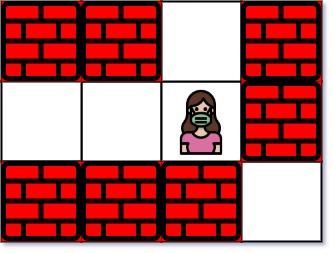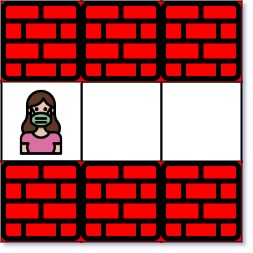- {x}
- Kth Smallest Subarray Sum
- Leetcodify Similar Friends
- Build Array from Permutation
- Eliminate Maximum Number of Monsters
- Count Good Numbers
- Longest Common Subpath
- Erect the Fence II
- Count Square Sum Triples
- Nearest Exit from Entrance in Maze
- Sum Game
- Minimum Cost to Reach Destination in Time
- Concatenation of Array
- Unique Length-3 Palindromic Subsequences
- Painting a Grid With Three Different Colors
- Merge BSTs to Create Single BST
- Check if String Is Decomposable Into Value-Equal Substrings
- Confirmation Rate
- Read More...

Nearest Exit from Entrance in Maze
You are given an m x n matrix maze (0-indexed) with empty cells (represented as '.') and walls (represented as '+'). You are also given the entrance of the maze, where entrance = [entrancerow, entrancecol] denotes the row and column of the cell you are initially standing at.
In one step, you can move one cell up, down, left, or right. You cannot step into a cell with a wall, and you cannot step outside the maze. Your goal is to find the nearest exit from the entrance. An exit is defined as an empty cell that is at the border of the maze. The entrance does not count as an exit.
Return the number of steps in the shortest path from the entrance to the nearest exit, or -1 if no such path exists.
Example 1:

Input: maze = [["+","+",".","+"],[".",".",".","+"],["+","+","+","."]], entrance = [1,2] Output: 1 Explanation: There are 3 exits in this maze at [1,0], [0,2], and [2,3]. Initially, you are at the entrance cell [1,2]. - You can reach [1,0] by moving 2 steps left. - You can reach [0,2] by moving 1 step up. It is impossible to reach [2,3] from the entrance. Thus, the nearest exit is [0,2], which is 1 step away.
Example 2:

Input: maze = [["+","+","+"],[".",".","."],["+","+","+"]], entrance = [1,0] Output: 2 Explanation: There is 1 exit in this maze at [1,2]. [1,0] does not count as an exit since it is the entrance cell. Initially, you are at the entrance cell [1,0]. - You can reach [1,2] by moving 2 steps right. Thus, the nearest exit is [1,2], which is 2 steps away.
Example 3:

Input: maze = [[".","+"]], entrance = [0,0] Output: -1 Explanation: There are no exits in this maze.
Constraints:
maze.length == mmaze[i].length == n1 <= m, n <= 100maze[i][j]is either'.'or'+'.entrance.length == 20 <= entrancerow < m0 <= entrancecol < nentrancewill always be an empty cell.
Solution Explanation: Nearest Exit from Entrance in Maze
This problem asks to find the shortest path from an entrance cell to any exit cell in a maze. An exit is defined as an empty cell on the border of the maze. The most efficient approach is using Breadth-First Search (BFS).
Approach:
BFS is ideal for finding the shortest path in an unweighted graph (like our maze). We treat empty cells as nodes and movements between adjacent empty cells as edges.
-
Initialization:
- Start with a queue
qcontaining theentrancecoordinates and its distance (0). - Mark the
entrancecell as visited (e.g., by changing its value in themazearray to '+').
- Start with a queue
-
BFS Iteration:
- While the queue is not empty:
- Dequeue the current cell
(row, col, distance). - Explore its four neighboring cells (up, down, left, right).
- For each neighbor:
- Check if it's within the maze boundaries.
- Check if it's an empty cell ('.'), and not already visited ('+').
- If it's an exit cell (on the maze border), return
distance + 1. - Otherwise, mark the neighbor as visited ('+'), enqueue it with
distance + 1, indicating its distance from the entrance.
- Dequeue the current cell
- While the queue is not empty:
-
No Exit Found:
- If the queue becomes empty without finding an exit, return -1.
Time Complexity Analysis:
- In the worst case, BFS visits every cell in the maze.
- The number of cells is
m * n, wheremis the number of rows andnis the number of columns. - Therefore, the time complexity is O(m * n).
Space Complexity Analysis:
- The space used is dominated by the queue.
- In the worst-case scenario, the queue could hold all the cells in the maze.
- Therefore, the space complexity is O(m * n).
Code Examples:
The code examples below implement the BFS approach in several programming languages. Note the slight variations in how the queue is managed and visited cells are marked. The core logic remains the same.
Python3:
from collections import deque
class Solution:
def nearestExit(self, maze: List[List[str]], entrance: List[int]) -> int:
m, n = len(maze), len(maze[0])
q = deque([(entrance[0], entrance[1], 0)]) # (row, col, distance)
maze[entrance[0]][entrance[1]] = '+' # Mark entrance as visited
while q:
row, col, dist = q.popleft()
for dr, dc in [(0, 1), (0, -1), (1, 0), (-1, 0)]:
new_row, new_col = row + dr, col + dc
if 0 <= new_row < m and 0 <= new_col < n:
if maze[new_row][new_col] == '.':
if new_row == 0 or new_row == m - 1 or new_col == 0 or new_col == n - 1:
return dist + 1
maze[new_row][new_col] = '+'
q.append((new_row, new_col, dist + 1))
return -1
Java:
import java.util.*;
class Solution {
public int nearestExit(char[][] maze, int[] entrance) {
int m = maze.length, n = maze[0].length;
Queue<int[]> q = new LinkedList<>();
q.offer(new int[] {entrance[0], entrance[1], 0}); // {row, col, dist}
maze[entrance[0]][entrance[1]] = '+';
while (!q.isEmpty()) {
int[] curr = q.poll();
int row = curr[0], col = curr[1], dist = curr[2];
for (int[] dr : new int[][] {{0, 1}, {0, -1}, {1, 0}, {-1, 0}}) {
int new_row = row + dr[0], new_col = col + dr[1];
if (new_row >= 0 && new_row < m && new_col >= 0 && new_col < n) {
if (maze[new_row][new_col] == '.') {
if (new_row == 0 || new_row == m - 1 || new_col == 0 || new_col == n - 1)
return dist + 1;
maze[new_row][new_col] = '+';
q.offer(new int[] {new_row, new_col, dist + 1});
}
}
}
}
return -1;
}
}(Other languages like C++, Go, TypeScript would follow a similar structure, adapting syntax and data structures accordingly.)